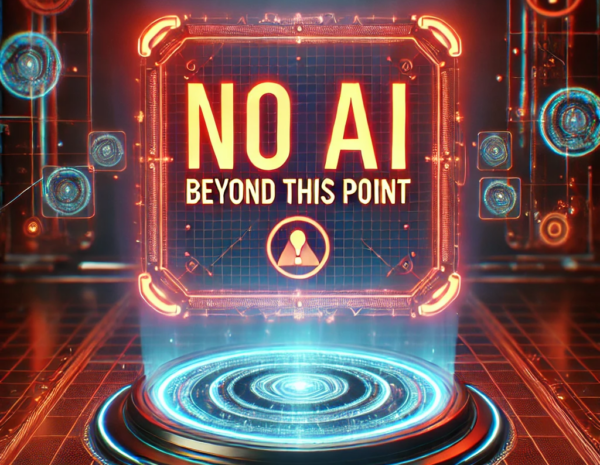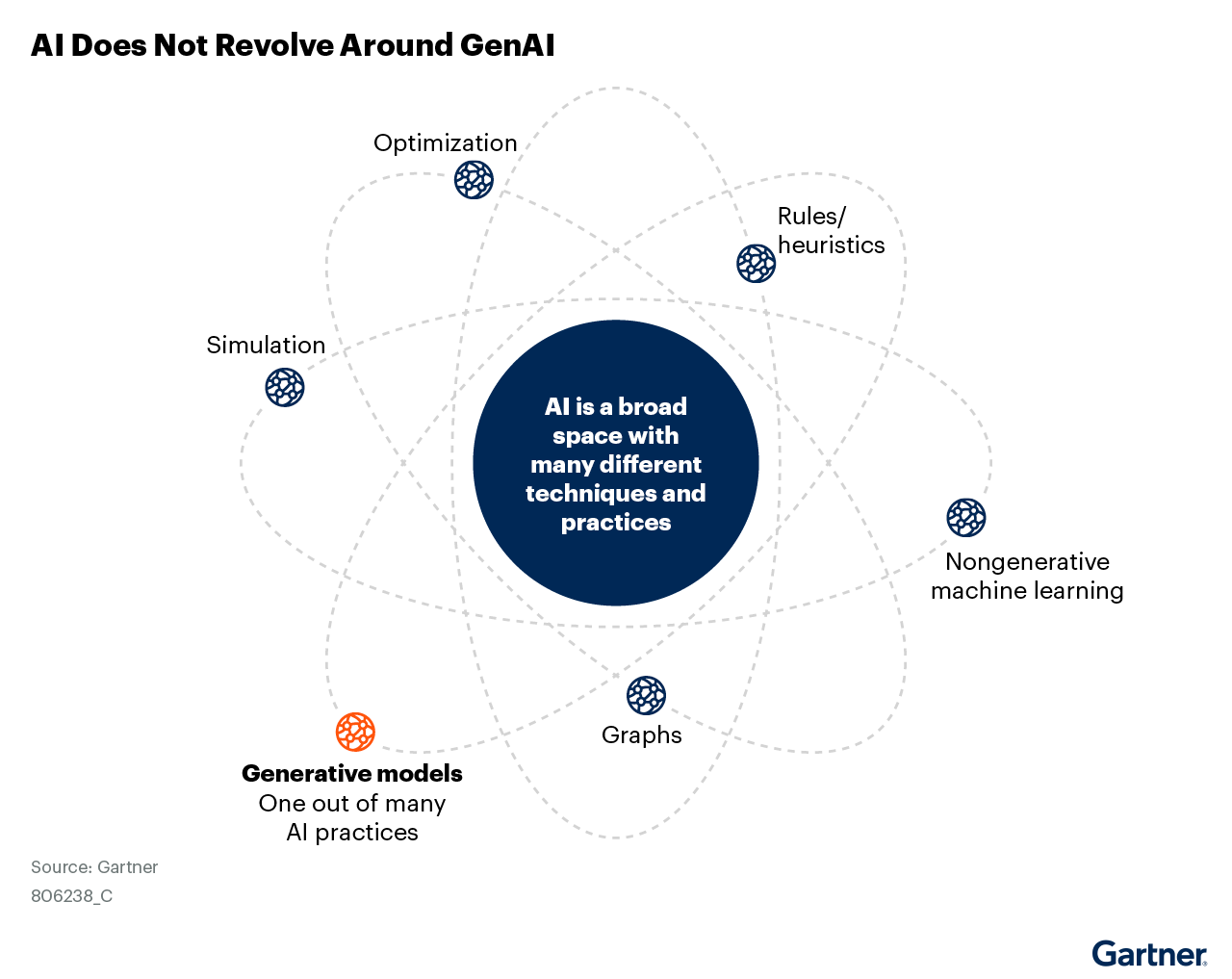Generative AI (GenAI) seems to be the solution for everything – from automatic text generation to process optimization. But what if using this technology in your company creates more problems than solutions?
According to a recent report by Gartner, GenAI not only holds potential, but also significant risks if used incorrectly. (Click here for the report on the Gartner website.) The report provides clear guidance for IT decision-makers and technical specialists: when is GenAI really worthwhile, and when are alternative AI techniques such as non-generative machine learning, simulations or knowledge graphs the better choice? We summarize the most important findings for you here.
What is generative AI – and what are its strengths?
GenAI is a specialized form of artificial intelligence that generates new content such as text, images, videos or even code. Well-known models such as GPT (for text), Claude or DALL-E (for images) are based on large neural networks that recognize patterns in data and use them to create new results.
However, generative AI is not a general-purpose solution. Gartner emphasizes that companies often overlook the broader AI field when they focus exclusively on GenAI. Different use cases require different techniques – and many problems can be solved more efficiently with other methods.
Comparison: GenAI vs. other AI techniques
AI technology
Focus
Typical Use Cases
Generative AI
content creation
Text, image and video generation, code generation, creative processes
non-generative ML
Predictions, pattern recognition
Sales forecasts, anomaly detection, recommendation systems
knowledge graphs
Structuring and visualising data relationships
Data management, fraud detection, search engines
optimisation techniques
Maximisation of efficiency and resource utilisation
route planning, financial portfolio optimisation, inventory management
rule-based systems
Decision-making based on rules
Fraud detection, medical diagnoses, quality control
simulations
Test and analyse scenarios
Financial modelling, architectural design, supply chain planning
A systematic consideration of alternative techniques shows that they are not only more efficient for many use cases, but also easier to understand and less risky. For example, simulations are particularly suitable for scenario analyses, while knowledge graphs can reduce GenAI hallucinations.
When GenAI works – and when it doesn’t
Gartner shows that GenAI is particularly convincing in creative areas, but often reaches its limits in technical and data-driven scenarios.
Areas of application in which GenAI shines
- Text generation and creative processes: creation of marketing materials, product descriptions or prototypes.
- Conversational user interfaces: chatbots and virtual assistants benefit from human-like responses.
- Knowledge capture and management: GenAI facilitates the analysis of large amounts of text and improves search functions.
Scenarios where GenAI fails
- Predictions and forecasts: Non-generative ML models are more suitable for numerical analyses such as sales forecasts.
- Planning and optimization: Tasks such as route planning or inventory management require precise calculations that GenAI cannot provide.
- Decision intelligence: Critical decisions require transparency and reliability, which GenAI often does not offer.
- Autonomous systems: GenAI models require close human supervision and are unsuitable for autonomous applications.
Use cases and recommended AI techniques
To help you decide which AI technique is suitable for your use case, here is an extended table:
Table: Overview of the use cases and usefulness of GenAI
family of use cases
Current usefulness of GenAI
Examples of use cases
Predictions and forecasts
Low
risk prediction, customer attrition prediction, sales/demand prediction
planning
Low
Operations research, optimisation, route planning
decision intelligence
Low
Decision support, extension, automation
autonomous systems
Low
Self-driving cars, advanced robotics, drones
segmentation/classification
Medium
Decision support, extension, automation
recommendation systems
Medium
Recommendation engine, personalised advice, next-best action
recognition
Medium
object recognition, analysis, detection
intelligent automation
Medium
Intelligent document processing, text recognition, robotic process automation, hyperautomation
Anomaly detection/monitoring
Medium
Detection of abnormal transactions, outlier detection, monitoring
content creation
High
Text generation, image and video generation, synthetic data
conversational user interfaces
High
Virtual assistants, chatbots, digital employees
knowledge discovery
High
Knowledge store, search, minin
The risks of GenAI: Why caution is advised
In addition to the limited application possibilities, GenAI harbors specific risks:
- Inaccuracies and “hallucinations”: GenAI often generates inaccurate or incorrect content, which is problematic in sensitive use cases.
- Privacy and security: Handling sensitive data can create legal and security challenges.
- Lack of transparency: The “black box” nature of GenAI makes it difficult to understand and explain the results – this is a particular problem when making critical decisions.
- Liability issues: Incorrect expenditure can lead to unexpected legal consequences.
For example, a financial services provider tried to use GenAI for budget forecasting. However, the results were unreliable because GenAI could not deliver precise calculations. Optimization techniques that are more accurate and transparent are therefore recommended here.
Combination of AI techniques: The best solution
One of the most promising approaches is to combine GenAI with other techniques. Knowledge graphs, for example, can reduce hallucinations, while simulations and optimization methods provide more precise results:
- Knowledge graphs and GenAI: Graphs provide structured knowledge that GenAI uses as a basis for more precise answers.
- Simulations and GenAI: GenAI can accelerate simulations by taking over parts of the calculations.
- Non-generative ML and GenAI: GenAI generates synthetic data that is used for predictive models.
Trends: The future of GenAI
Generative AI (GenAI) has enormous potential, but its success lies in intelligent integration with other technologies and adaptation to new requirements. Gartner emphasizes that GenAI benefits most from hybrid approaches: Knowledge graphs provide structured data that GenAI transforms into accurate content, while simulations with synthetic data enable more realistic scenarios.
Another important trend is the specialization of models. Domain-specific AI solutions that are trained on industry-specific data sets deliver greater accuracy and relevance. In medicine, for example, specialized models could create clinical reports faster and more accurately or analyze medical studies to prepare relevant findings for research teams. In manufacturing, they can automatically create complex technical documentation while adhering to industry-specific standards and terminology. At the same time, such specialized models reduce energy consumption, making them cost-efficient and sustainable.
At the same time, the need for transparency is growing. Explainable AI (XAI) is becoming the standard in order to meet regulatory requirements such as the EU AI Regulation and to strengthen user confidence. Models that make their decisions comprehensible offer decisive advantages, particularly in business-critical applications such as finance or healthcare.
Easy access to GenAI, for example through low-code tools, is also promoting its spread. However, this harbors risks: Gartner warns against ill-considered deployment and advises to carefully examine the objectives and use cases. Sustainability also remains a key issue. More efficient models and the use of renewable energy in data centers are the first steps towards reducing high energy consumption and making GenAI more environmentally friendly.
The future of GenAI depends on how well companies utilize their opportunities, combine technologies and focus on sustainability and transparency.
You can find out more about AI here:
How AI is revolutionizing the energy supply for the mobility transition
Use of artificial intelligence and large language models in particular
Innovative AI strategy: Sulzer develops its own chatgpt based assistant
Sulzer and Databricks partner for AI-driven data innovation
Do you have the right AI strategy?
Our experts will help you find the best approach for your requirements.





